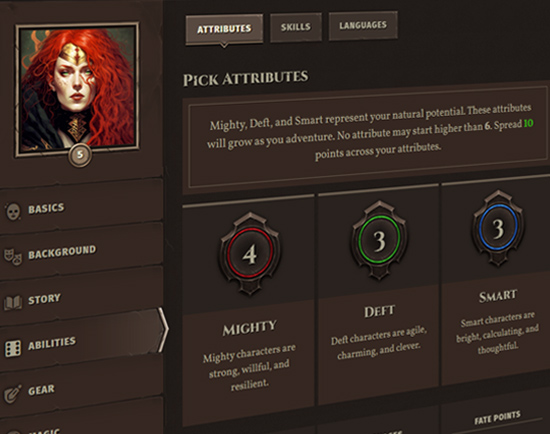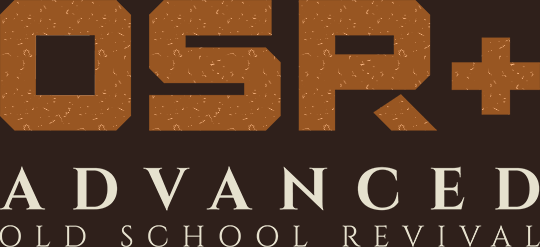In theater of mind play, the entirety of the scene is considered an encounter space. The scene may be any size as described by the GM: if the scene encompasses a coliseum, then the whole of the coliseum is the encounter space; if the scene takes place on the deck of a boat, then the encounter space is the deck of the boat.
Put another way, the space of an encounter has no specific dimensions except in the context of a scene. This allows us to figure out the relative distances without having to resort to specific units of measurement, based on the fictional size of the encounter.
Types of Spaces
Personal Space
A personal space is the area immediately surrounding you and anything you can reach without moving. Only a single character can occupy a personal space. Usually the size of this space is pretty consistent, independent of how big the encounter is. On a hex grid, a personal space would be your hex plus any hexes adjacent to you, but for the purposes of spell effects or other targets, a personal space can only affect one character.
Melee Space
A melee space is the distance you can move (at a brisk pace) in a single turn, while taking an action. For example, if the encounter is a football field, it's likely four melee spaces across; if the encounter is the deck of a boat, it might only contain two melee spaces. A melee space is always at most half as large as the encounter (or at most half as many hexes as the battlemap).
Encounter Space
An encounter space encompasses the entire scene. If you forgo your action (and with the GM's discretion), you can run the entirety of an encounter space on your turn. Moreover, the entirety of the hex grid would constitute the encounter space.
Interpreting Smaller Spaces
Note that it's possible for a scene to be restricted to much smaller spaces, making the distinction between melee and encounter distances more difficult to suss out. For example, if the scene is a tavern bar, the entire bar is considered the encounter. Traveling halfway across the bar might be considered a melee space, whereas the space within your reach without moving would be considered a personal space.
Common sense might say that you can move across the whole bar on your turn, despite that the bar is the encounter space; however the GM might rule that if there's commotion in the bar, you can only move across half of it on your turn, using the commotion as a way to establish a melee space in the scene.
Always let common sense prevail over these rules as written, but defer to your GM for a ruling.
Weapon Ranges
In the real world, most weapons have granular effective ranges that wouldn't make sense in the context of encounter spaces. Because in OSR+ all weapons are abstracted into one of a handful of weapon classes, we treat all weapons in a weapon class the same way with respect to their effective ranges. To this end, there are only ranged and melee weapons.
Ranged Weapons
Ranged weapons include Thrown, Firearms, and Missile weapon classes.
Such weapons have an effective range of a melee space, meaning that in order to deliver damage, the target must be no farther away than a melee space. A ranged weapon can certainly reach a target at the edge of the encounter, but it may require attacking at disadvantage or concentrating for longer than a turn, at the GM's discretion.
If you use a ranged weapon as a melee weapon, it can deliver damage, but you may not apply the weapon skill to your attack roll in that case (even if you're skilled in melee weapons).
Melee Weapons
Melee weapons include Blunt, Edged, Flexible, Hand-to-Hand, Heavy, Light, Reach, and Small weapon types. These weapons are not meant to be thrown at any distance, and so the target must be within a personal space for you to deliver damage when using them.
If you throw a melee weapon, it can travel the distance of melee space, but you may not apply the weapon skill to your attack roll in that case (even if you're skilled in Thrown weapons) and the attack roll is made at disadvantage.
Beyond Encounter Spaces
The rules will rarely specify exact units of measurement when discussing distances, because distance in an encounter space will always be relative to the size of the scene.
However, some spells, treasures, or abilities may specify a specific unit of distance to give you an idea of the potential scope of the ability or item, etc. For example, a spell might say "miles per MP" rather than refer to encounter spaces.
When such distances would exceed the size of the scene, look to the GM for a ruling. Typically, when measuring additional encounter spaces beyond the first, the GM will use the size of the encounter as a baseline. For example, if some ability would affect 3 encounter spaces, and the scene is the size of a football field, then the ability would affect 3 football fields.
 Archetypes
Archetypes Armor
Armor Classes
Classes Conflicts
Conflicts Cultures
Cultures Ethos
Ethos Flaws
Flaws Glossary
Glossary Kits
Kits Maleficence
Maleficence Origins
Origins Shields
Shields Skills
Skills Spells
Spells Stances
Stances Status Effects
Status Effects Tactics
Tactics Talents
Talents Techniques
Techniques Treasure
Treasure Weapons
Weapons











 Hall of Heroes
Hall of Heroes Hall of Legends
Hall of Legends



 Dungeons & Flagons
Dungeons & Flagons